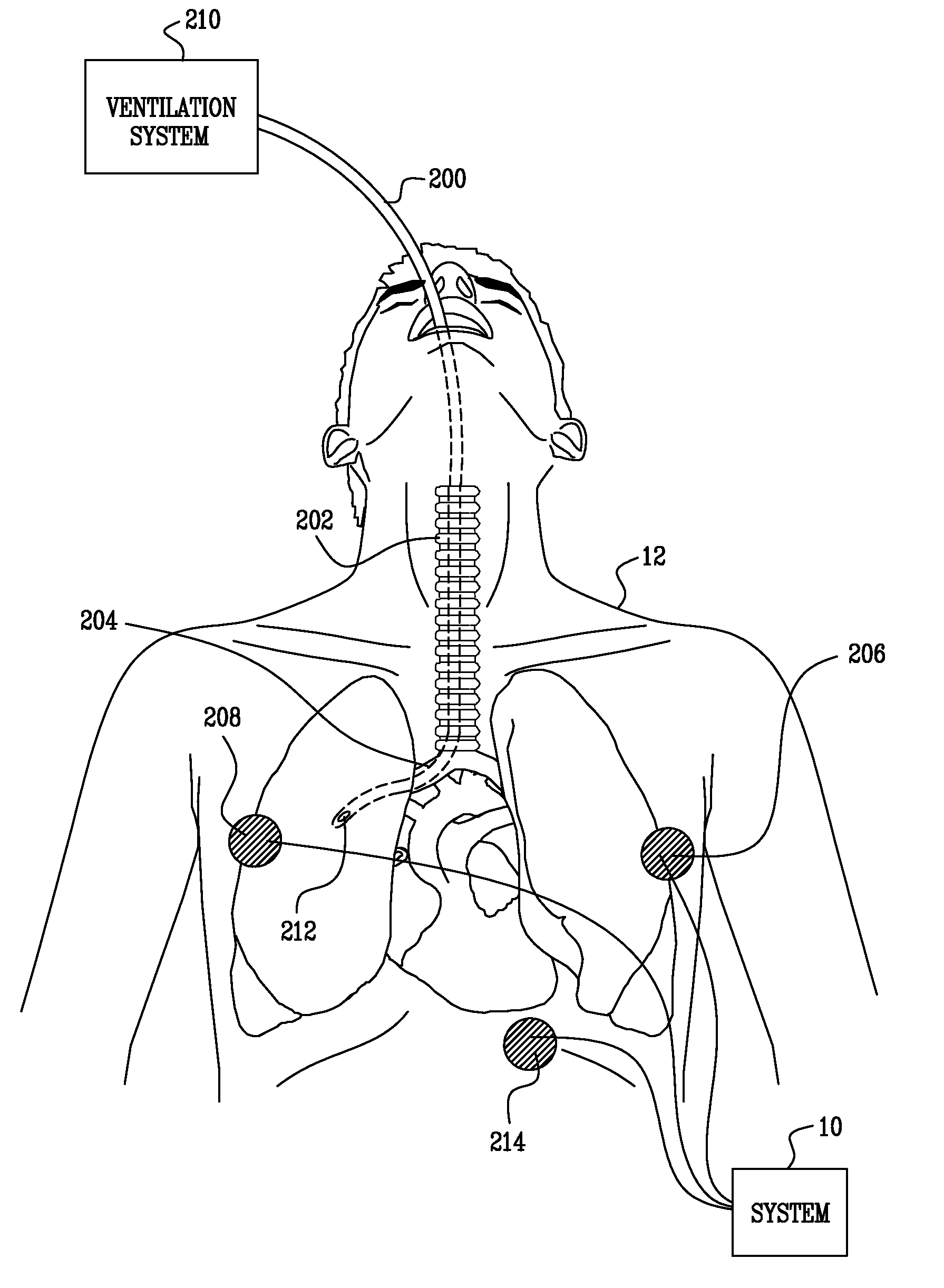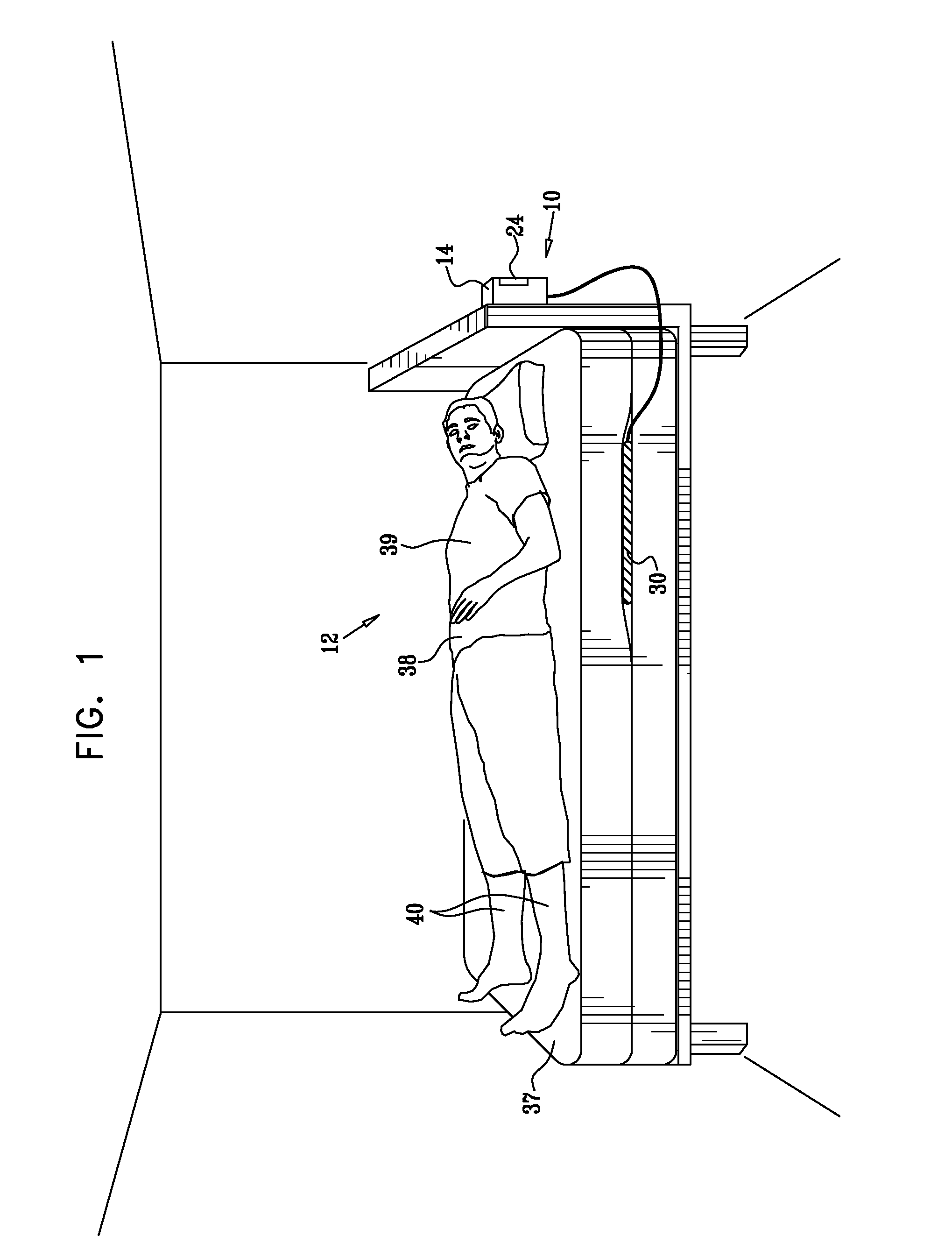Monitoring endotracheal intubation
a technology of endotracheal intubation and monitoring patient, which is applied in the field of monitoring patients and predicting and monitoring abnormal physiological conditions, can solve problems such as asthma management, abnormal patterns related to the cause of modification, and abnormal breathing and heartbeat patterns, and achieve the effect of reducing the effects of the ailmen
- Summary
- Abstract
- Description
- Claims
- Application Information
AI Technical Summary
Benefits of technology
Problems solved by technology
Method used
Image
Examples
example 1
[0883]Sensor A receives a compound signal comprised of a superposition of a signal s(t) and noise e(t): x(t)=s(t)+e(t).
[0884]Sensor B receives a projection of the noise denoted e′(t).
[0885]For this example, assume that Signal s(t) and noise e(t) are uncorrelated. The signal s(t) is extracted via adaptive elimination of a reconstructed noise signal from the compound signal plus noise x(t) received by sensor A, by minimizing the mean-square difference: MIN {[[s(t)+e(t)]−h(t)*e′(t)]̂2}, wherein h(t) denotes the impulse response of a linear time-invariant (LTI) filter.
[0886]Solving for h(t) yields the desired solution: s(t)=x(t)−h(t)*e′(t).
example 2
[0887]Sensors A and B receive different projections of a compound signal comprised of a superposition of a signal s(t) and noise e(t). For this example, assume that:
[0888]signal x(t) and noise e(t) are uncorrelated; and
[0889]signal and / or noise spectrum are known.
[0890]The axes are rotated to enhance signal and / or noise projections, until the desired characteristic spectrum is achieved, as follows (alpha and beta are incidence angles of the signal and noise, respectively):
[0891]Sensor A reads: S1(t)=x(t)*sin(alpha)+e(t)*sin(beta)
[0892]Sensor B reads: S2(t)=x(t)*cos(alpha)+e(t)*cos(beta)
[0893]The axes are rotated by gamma degrees, yielding:
S1′(t)=S1(t)*cos(gamma)+S2(t)*sin(gamma)
S2′(t)=S1(t)*sin(gamma)+S2(t)*cos(gamma)
[0894]The rotated signals S1′(t) and S2′(t) are calculated for all angles until noise contribution is cancelled (when gamma=pi-beta), and a scaled version of the desired signal is obtained:
S1′(t)=[x(t)*sin(alpha)+e(t)*sin(beta)]*cos(gamma)+[x(t)*cos(alpha)+e(t)*cos(beta...
example 3
[0895]Identical sensors A and B are placed in close proximity and at the same orientation. Both sensors receive a superposition of near field signals and far field noise.
[0896]For this example, assume that:[0897]the distance between the sensors is significantly smaller than their distance from the noise source, but is of the order of magnitude of the distance from the signal source; and[0898]the signal source is comprised of a superposition of at least two differently oriented signal sources. For simplicity, the following description assumes two signal sources.
[0899]Let x1(t) and x2(t) denote the two near field signal sources.
[0900]Let e(t) denote the far field noise signal.
[0901]Sensor A reads: S1(t)=x1(t)+e(t)
[0902]Sensor B reads: S2(t)=x2(t)+e(t)
[0903]Then the difference signal is:
Sdiff=S1(t)+S2(t)=x1(t)-x2(t)+e(t)-e(t)=X1(t)-x2(t)
[0904]Thus, the far field signal is suppressed.
PUM
 Login to View More
Login to View More Abstract
Description
Claims
Application Information
 Login to View More
Login to View More - R&D
- Intellectual Property
- Life Sciences
- Materials
- Tech Scout
- Unparalleled Data Quality
- Higher Quality Content
- 60% Fewer Hallucinations
Browse by: Latest US Patents, China's latest patents, Technical Efficacy Thesaurus, Application Domain, Technology Topic, Popular Technical Reports.
© 2025 PatSnap. All rights reserved.Legal|Privacy policy|Modern Slavery Act Transparency Statement|Sitemap|About US| Contact US: help@patsnap.com



